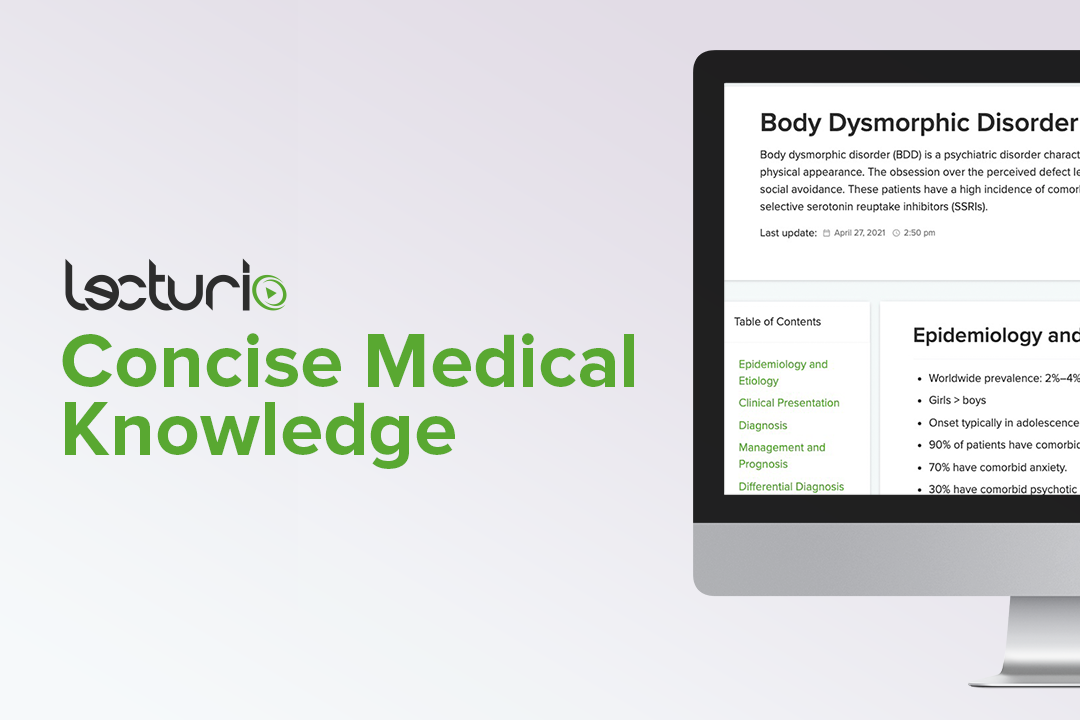Playlist
Show Playlist
Hide Playlist
Body Dysmorphic Disorder and Pain Disorder
-
Slides SomatoformOtherDisorders Psychiatry.pdf
-
Download Lecture Overview
00:00 Let’s talk about Body Dysmorphic Disorder briefly. So here’s an example. “A 25-year-old single man spends hours everyday looking into the mirror. He is convinced that a scar above his lip makes him look unattractive. He stopped going out with friends and now works from home because he’s so concerned about the scar that he believes he is grotesque and can’t go out into public. 00:25 So he comes in to the doctor’s office asking for help to conceal his scar. On inspection, the doctor finds the scar is barely even visible and there is really no intervention that would be ethically recommended but the man says that regardless he wants a referral to a plastic surgeon." So body dysmorphic disorder is really a preoccupation with body parts that are perceived by an individual somehow being flawed and patients will often perceive themselves as being grotesque. 00:57 It’s extreme self-consciousness. It can lead to isolation and excessive focus on body image with staring in the mirror for hours and during the day and it can also lead to multiple and very expensive plastic surgery visits. Body dysmorphic disorder is imagined ugliness and it was first described over 100 years ago. It tends to affect females more than males, more common in unmarried people and it’s an illness of youth so usually late teens or early 20’s are affected. 01:34 About 90% of people actually have a co-existing depressive disorder, 70% will have anxiety and about a third of people may have a psychotic disorder. So here are the diagnostic criteria. 01:46 You’re looking for a patient who believes that they have a facial deformity, asymmetry of something on their body but they’re too ashamed to present for treatment. They frequently check and groom themselves, they may try to compensate for an imagined anomaly and complications will often lead to social isolation. So, our man who is seeking out a plastic surgeon to correct a barely visible scar, that sounds like body dysmorphic disorder. Well, how would you go about treating this disorder? Surgeries and dermatologic procedures are routinely unsuccessful because once they are done, the patient just finds something else to ruminate about. Antidepressants like SSRIs can be helpful in patients especially for those who have a comorbid depression, which we know does go hand in hand with body dysmorphic disorder. Now let’s talk about pain. So, what are pain disorders? Well, they are prolonged severe discomfort without any adequate medical explanation. Pain often coexists with a medical condition but is not directly caused by it and patients often have a history of multiple visits to their doctors and this can be acute under 6 months or it can be chronic. Females tend to be more affected and usually it comes on around age 30 to 50 and there is an increased incidence in first degree relatives. There’s also increased incidence in blue-collar workers, people who are susceptible to incurring injuries and patients have a very high incidence of comorbidities like depression, anxiety and also substance abuse. 03:32 When it comes to pain, it’s imperative that you first rule out any organic or general medical cause of the pain. The differential diagnosis beyond that will include hypochondriasis and also malingering. Note that analgesics are actually not helpful unless there’s a physical or medical problem contributing to pain. When it’s a pain disorder from a psychiatric standpoint, analgesics won’t help and in fact patients will only become dependent on them and they’re already at high risk for substance abuse. You might try treating with an SSRI or maybe a nerve block. Biofeedback has been found to be very helpful as has hypnosis and psychotherapy is also a great way to help your patient better understand and manage their pain through other techniques like mindfulness.
About the Lecture
The lecture Body Dysmorphic Disorder and Pain Disorder by Helen Farrell, MD is from the course Dissociative Disorders. It contains the following chapters:
- Body Dysmorphic Disorder
- Pain Disorder
- Malingering
Included Quiz Questions
Which of the following best describes body dysmorphic disorder?
- It is a condition where the person is preoccupied with body parts they perceive as flawed or defective and consider themselves as grotesque.
- It is a disorder where a patient will intentionally produce medical or psychological symptoms in order to assume the role of a sick patient.
- It is a condition of faking or exaggerating symptoms for an obvious external benefit like money or disability.
- It is a condition where the patient has prolonged, exaggerated concern about health and possible illness.
- It is the persistent or recurrent feeling of detachment from one’s self, environment, or social situation.
Which of the following statements regarding body dysmorphic disorder is FALSE?
- It is more common in married men.
- The patients have an extreme sense of self-consciousness and isolation.
- The average age of onset is 15-20 years old.
- Co-existing conditions include major depression, anxiety, and psychotic disorder.
- The patients are too ashamed and often develop social isolation.
Which of the following statements regarding pain disorders is TRUE?
- It is a prolonged, severe discomfort without adequate medical explanation often co-existing with a medical condition but is not directly caused by it.
- The acute pain disorder lasts for < 3 months while it is considered chronic when the symptoms are beyond 3 months.
- There is NOT an increased incidence in first-degree relatives.
- Depression and anxiety are co-morbidities.
Which of the following is NOT helpful in the management of pain disorder?
- Analgesics
- Psychotherapy
- SSRIs
- Hypnosis
- Bio-feedback
A 17-year-old girl presents to a pediatrician with her mother, who says that her daughter spends 3 hours each day getting ready in order to hide a 1-cm scar on her right arm. During the interview, the girl frequently voices concerns about her appearance. What condition could she likely have?
- Body dysmorphic disorder
- Normal teenage behavior
- Somatoform disorder
- Anorexia nervosa
- Obsessive-compulsive disorder
Customer reviews
5,0 of 5 stars
| 5 Stars |
|
5 |
| 4 Stars |
|
0 |
| 3 Stars |
|
0 |
| 2 Stars |
|
0 |
| 1 Star |
|
0 |





